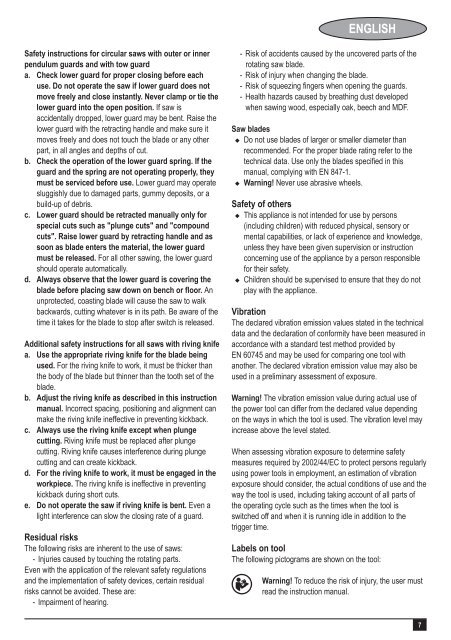BlackandDecker Scie Circulaire- Ks40 - Type 1 - Instruction Manual (Européen)
BlackandDecker Scie Circulaire- Ks40 - Type 1 - Instruction Manual (Européen)
BlackandDecker Scie Circulaire- Ks40 - Type 1 - Instruction Manual (Européen)
You also want an ePaper? Increase the reach of your titles
YUMPU automatically turns print PDFs into web optimized ePapers that Google loves.
ENGLISH<br />
Safety instructions for circular saws with outer or inner<br />
p<strong>en</strong>dulum guards and with tow guard<br />
a. Check lower guard for proper closing before each<br />
use. Do not operate the saw if lower guard does not<br />
move freely and close instantly. Never clamp or tie the<br />
lower guard into the op<strong>en</strong> position. If saw is<br />
accid<strong>en</strong>tally dropped, lower guard may be b<strong>en</strong>t. Raise the<br />
lower guard with the retracting handle and make sure it<br />
moves freely and does not touch the blade or any other<br />
part, in all angles and depths of cut.<br />
b. Check the operation of the lower guard spring. If the<br />
guard and the spring are not operating properly, they<br />
must be serviced before use. Lower guard may operate<br />
sluggishly due to damaged parts, gummy deposits, or a<br />
build-up of debris.<br />
c. Lower guard should be retracted manually only for<br />
special cuts such as "plunge cuts" and "compound<br />
cuts". Raise lower guard by retracting handle and as<br />
soon as blade <strong>en</strong>ters the material, the lower guard<br />
must be released. For all other sawing, the lower guard<br />
should operate automatically.<br />
d. Always observe that the lower guard is covering the<br />
blade before placing saw down on b<strong>en</strong>ch or floor. An<br />
unprotected, coasting blade will cause the saw to walk<br />
backwards, cutting whatever is in its path. Be aware of the<br />
time it takes for the blade to stop after switch is released.<br />
Additional safety instructions for all saws with riving knife<br />
a. Use the appropriate riving knife for the blade being<br />
used. For the riving knife to work, it must be thicker than<br />
the body of the blade but thinner than the tooth set of the<br />
blade.<br />
b. Adjust the riving knife as described in this instruction<br />
manual. Incorrect spacing, positioning and alignm<strong>en</strong>t can<br />
make the riving knife ineffective in prev<strong>en</strong>ting kickback.<br />
c. Always use the riving knife except wh<strong>en</strong> plunge<br />
cutting. Riving knife must be replaced after plunge<br />
cutting. Riving knife causes interfer<strong>en</strong>ce during plunge<br />
cutting and can create kickback.<br />
d. For the riving knife to work, it must be <strong>en</strong>gaged in the<br />
workpiece. The riving knife is ineffective in prev<strong>en</strong>ting<br />
kickback during short cuts.<br />
e. Do not operate the saw if riving knife is b<strong>en</strong>t. Ev<strong>en</strong> a<br />
light interfer<strong>en</strong>ce can slow the closing rate of a guard.<br />
Residual risks<br />
The following risks are inher<strong>en</strong>t to the use of saws:<br />
- Injuries caused by touching the rotating parts.<br />
Ev<strong>en</strong> with the application of the relevant safety regulations<br />
and the implem<strong>en</strong>tation of safety devices, certain residual<br />
risks cannot be avoided. These are:<br />
- Impairm<strong>en</strong>t of hearing.<br />
- Risk of accid<strong>en</strong>ts caused by the uncovered parts of the<br />
rotating saw blade.<br />
- Risk of injury wh<strong>en</strong> changing the blade.<br />
- Risk of squeezing fingers wh<strong>en</strong> op<strong>en</strong>ing the guards.<br />
- Health hazards caused by breathing dust developed<br />
wh<strong>en</strong> sawing wood, especially oak, beech and MDF.<br />
Saw blades<br />
u Do not use blades of larger or smaller diameter than<br />
recomm<strong>en</strong>ded. For the proper blade rating refer to the<br />
technical data. Use only the blades specified in this<br />
manual, complying with EN 847-1.<br />
u Warning! Never use abrasive wheels.<br />
Safety of others<br />
u This appliance is not int<strong>en</strong>ded for use by persons<br />
(including childr<strong>en</strong>) with reduced physical, s<strong>en</strong>sory or<br />
m<strong>en</strong>tal capabilities, or lack of experi<strong>en</strong>ce and knowledge,<br />
unless they have be<strong>en</strong> giv<strong>en</strong> supervision or instruction<br />
concerning use of the appliance by a person responsible<br />
for their safety.<br />
u Childr<strong>en</strong> should be supervised to <strong>en</strong>sure that they do not<br />
play with the appliance.<br />
Vibration<br />
The declared vibration emission values stated in the technical<br />
data and the declaration of conformity have be<strong>en</strong> measured in<br />
accordance with a standard test method provided by<br />
EN 60745 and may be used for comparing one tool with<br />
another. The declared vibration emission value may also be<br />
used in a preliminary assessm<strong>en</strong>t of exposure.<br />
Warning! The vibration emission value during actual use of<br />
the power tool can differ from the declared value dep<strong>en</strong>ding<br />
on the ways in which the tool is used. The vibration level may<br />
increase above the level stated.<br />
Wh<strong>en</strong> assessing vibration exposure to determine safety<br />
measures required by 2002/44/EC to protect persons regularly<br />
using power tools in employm<strong>en</strong>t, an estimation of vibration<br />
exposure should consider, the actual conditions of use and the<br />
way the tool is used, including taking account of all parts of<br />
the operating cycle such as the times wh<strong>en</strong> the tool is<br />
switched off and wh<strong>en</strong> it is running idle in addition to the<br />
trigger time.<br />
Labels on tool<br />
The following pictograms are shown on the tool:<br />
:<br />
Warning! To reduce the risk of injury, the user must<br />
read the instruction manual.<br />
7
















